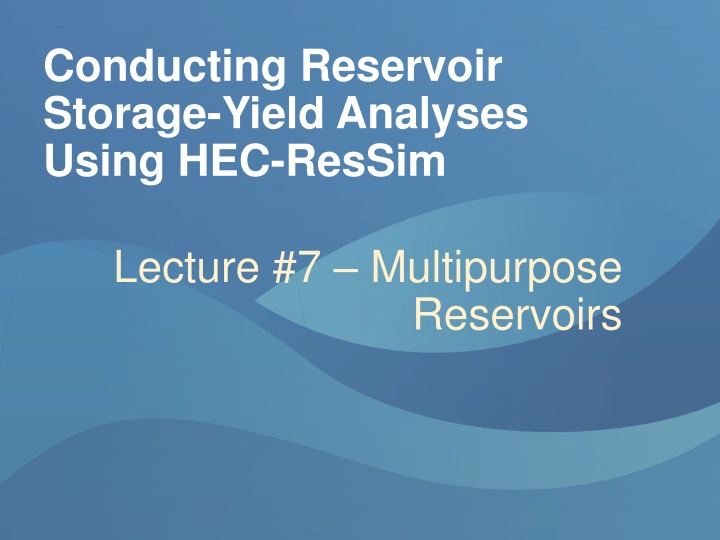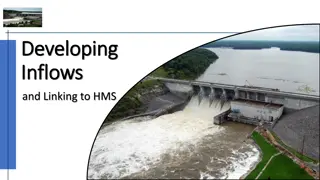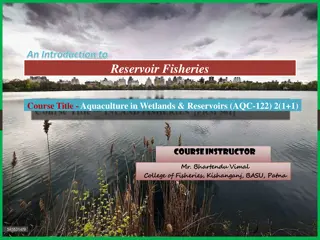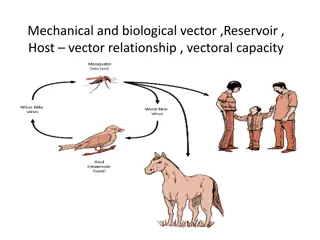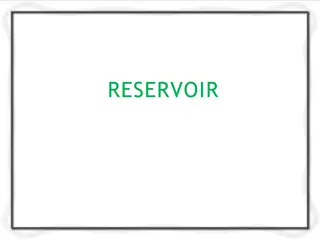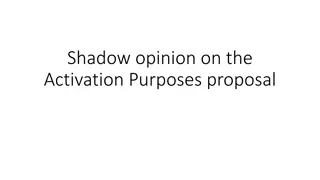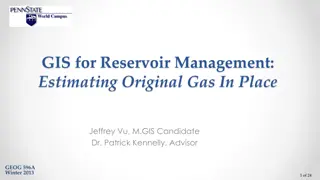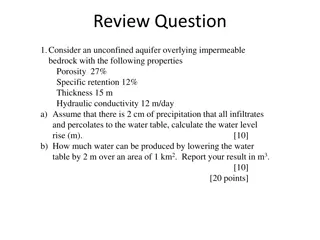Managing Multiple Purposes in Reservoir Operations
Reservoirs with multiple purposes can present challenges in balancing competing needs such as water supply, flood risk management, hydropower generation, and more. Understanding the interactions between these purposes is essential for optimizing reservoir operations and ensuring reliable water supply. This article delves into the complexities of managing different reservoir objectives and the impact they have on firm yield, operational decisions, and modeling considerations.
Download Presentation

Please find below an Image/Link to download the presentation.
The content on the website is provided AS IS for your information and personal use only. It may not be sold, licensed, or shared on other websites without obtaining consent from the author.If you encounter any issues during the download, it is possible that the publisher has removed the file from their server.
You are allowed to download the files provided on this website for personal or commercial use, subject to the condition that they are used lawfully. All files are the property of their respective owners.
The content on the website is provided AS IS for your information and personal use only. It may not be sold, licensed, or shared on other websites without obtaining consent from the author.
E N D
Presentation Transcript
Conducting Reservoir Storage-Yield Analyses Using HEC-ResSim Lecture #7 Multipurpose Reservoirs
Introduction Consider reservoirs with multiple purposes Discuss effects of other purposes on firm yield Evaluate different kinds of operations and diversions and how they interact Discuss modeling challenges with multipurpose reservoirs
Multiple Purposes Reservoirs can have many authorized purposes Water Supply Flood risk management Hydropower Navigation Fish and Wildlife benefits Recreation
Multiple Purposes Purposes will interact and affect each other, and operating for one purpose may constrain others The Water Control Manual defines operational balance for all purposes Operators do have some discretion within WCM limits Some purposes will lower firm yield, while others will not Competing vs. complementary purposes
Water Supply Water supply is the primary focus of this course Many yield studies are concerned with firm yield for water supply Our lectures and workshops so far have assumed water supply is the only purpose of the reservoir Water supply will benefit from larger storage volumes and lower releases to other purposes
Flood Risk Management Flood risk management typically competes with yield Flood risk management requires keeping empty space in the reservoir Water supply requires storing water until needed The competition can be reduced if the flood season is limited More water can be stored for supply during seasons that floods are unlikely Seasonal guide curves Conditional guide curves
Hydropower Hydropower requires releasing water from the reservoir through turbines Impact on firm yield for water supply depends on the layout of the system Supply diversions pulled directly from the reservoir pool will compete with hydropower Supply diversions below the turbines are complementary with hydropower
Hydropower Diversions from reservoir pool vs. downstream diversions Downstream diversion Town Powerplant Res City Diversion from reservoir pool
Hydropower Diversionsfrom reservoir pool typically compete with all uses (except flood risk management) Less water is available in the reservoir to release for other purposes The diverted water does not benefit any other purpose Downstream diversion Town Powerplant Res City Diversion from reservoir pool
Hydropower Downstream diversions can be complementary with some purposes Releasing for the diversion can also generate power Navigation or environmental benefits are created between the dam and the diversion point Downstream diversion Town Powerplant Res City Diversion from reservoir pool
Navigation Navigation benefits require water in the channel to keep it deep enough will typically compete with water supply 1. Impact on firm yield depends on location Downstream diversions will pull water from the channel while navigation requires the water to stay in the channel But, navigation above the diversion is cooperative 2. Timing of use of stored water can also be in competition Diversions from the reservoir will allow less water for navigation releases later
Fish and Wildlife The impact of Fish and Wildlife benefits will depend on the specific benefit 1. Holding the reservoir higher during certain seasons may improve yield overall 2. Increasing downstream flow will hurt reservoir pool diversions, but could benefit diversions below the critical reach Releasing more water downstream uses storage and so reduces later releases
Portion of Pool Is yield of 50% of the pool equal to 50% of the full yield? Earlier, we assumed yes More complicated with multiple purposes Can depend on specific operation details Can be difficult to model precisely
HEC-ResSim Decision Process Goal is to represent actual operation and policy accurately Includes operating for multiple purposes In ResSim, we can use rules and operating zones Rules define release thresholds in the current time step Rules are placed in zones, in a priority order Rule priorities are needed to resolve conflicts between rules It can be difficult to fit operational decision making into a set of prioritized rules
HEC-ResSim Decision Process Min and max rules create an envelope of acceptable flows The model will try to reach guide curve quickly, subject to envelope limits The most constraining rule of each limit type will set the release limits -- ie, the smallest max, largest min If min and max rules conflict (min is larger than max, vice versa) rule priority is used
HEC-ResSim Decision Process How do we make sure the water supply rule does not harm other purposes, or other purposes don t harm water supply? Yield Analysis Tool will ensure that all higher- priority rules are satisfied in every time step, while maximizing yield A higher priority minimum release rule failing to meet its minimum flow will cause the water supply rule to also fail, prompting another iteration Operating zones can help separate different operations. Flood risk management is needed at higher elevations, some operations like recreation releases may be curtailed at low elevations
Operations One possibility is operating zones Each purpose can be limited to certain zones Does not always work well for purposes that operate in the same zone.
Class Discussion How might we setup zones and rules to model flood risk management, water supply, and hydropower in this system? Downstream diversion Town Powerplant Res City Diversion from reservoir pool
Operations Are there other options? Inflow apportionment? Vertical Zones? Stay Tuned!
Workshop #4 Multipurpose Reservoirs Adding other purposes to our model Prioritizing rules Analyzing different system layouts
Knowledge Check What is the difference between competing and complementary purposes? Competing purposes compete for available water. Improving one purpose requires reducing the other. Prioritizing is needed in order to fully specify operations for modeling. Complementary purposes can both benefit from the same water, and both can be improved at the same time. Prioritizing may not be needed. Do flood risk management and hydropower compete with or compliment each other? They can do either, depending on the reservoir condition. Passing stored flood water through the turbines will benefit power. However, keeping the reservoir lower to provide more flood risk management space will reduce head for the turbines, and limit storage of water that could be used for power in a future drought.
Knowledge Check How does modeling navigation rules with higher priority than water supply impact firm yield in HEC- ResSim? What if the navigation rule priority is lower? High priority navigation will release water from the pool whenever natural downstream flows are too low. If navigation rules are ever shorted, the water supply rule will also fail, and the yield tool will reduce demand in the next iteration. Water released for navigation will not be available for water supply later, and the yield will be lower than without the navigation rule. Ideally, if navigation is lower priority, yield should NOT be affected. But, HEC-ResSim does not know to protect water supply storage for future use, and so yield WILL be affected. Navigation releases made when water is plentiful will lower yield if the plentiful period turns out to be the beginning of the critical drought.
Knowledge Check How could a model ensure firm yield does not decrease due to lower priority rules? Horizontal operation zones such as flood and con pools offer some protection for higher priority rules, but can still allow a lower priority rule to impact yield. Splitting the pool vertically (water accounts), so that each rule can use water at any reservoir elevation AND reserve its own water, can help reduce impacts between objectives. We will discuss this idea in more detail later.
